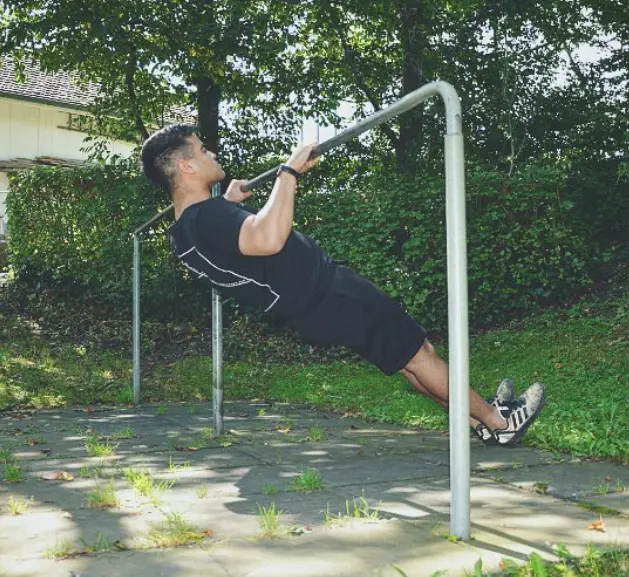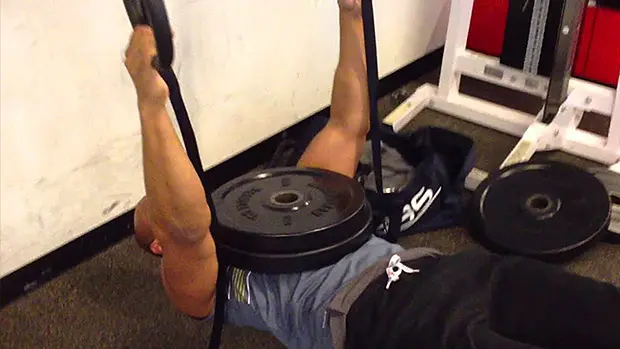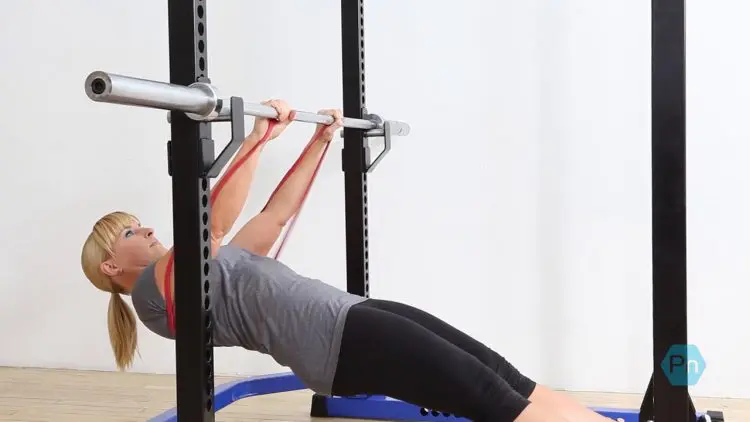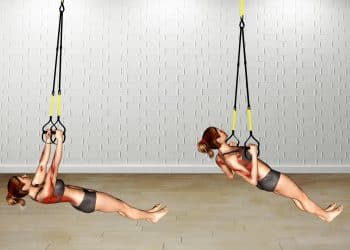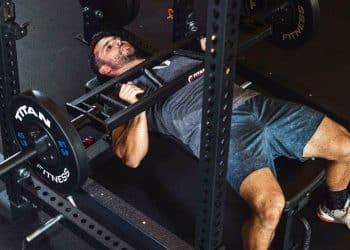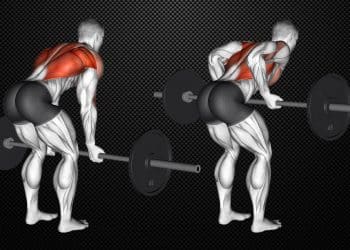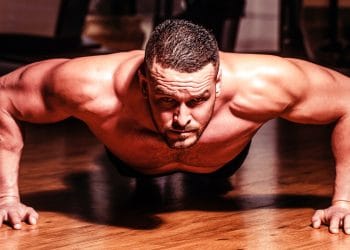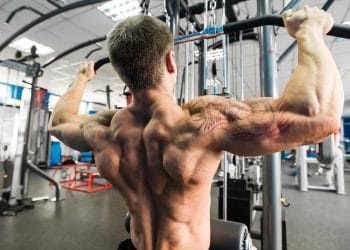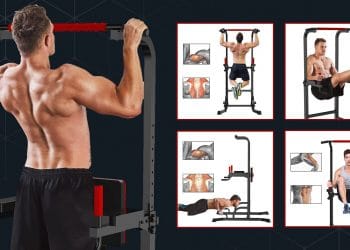When it comes to bodyweight exercises, back builders are relatively few and far between. There are lots of lower body exercises to choose from and dozens of push-up variations to try. But, for lats, pull-ups and chin-ups are the most obvious exercises.
Unfortunately, unless you’ve got some resistance bands, an assisted chin/dip machine, or a VERY willing spotter, doing pull-ups and chin-ups involves lifting your entire body weight using just your arms.
If you are a beginner or a little on the large side, this can be a big ask. For many exercisers, doing even a single pull-up or chin-up is a significant achievement.
Of course, you can work your lats using barbells, dumbbells, or use a lat pulldown or seated row machine, but what if you don’t have access to any gym equipment? How do you train your lats then?
The good news is that there is another way to work your lats that a) doesn’t involve much equipment and b) is easier than full pull-ups and chin-ups – Australian pull-ups.
In this article, we reveal how to do Australian pull-ups and provide you with a few alternatives, variations, and performance-boosting tips.
Level Up Your Fitness: Join our 💪 strong community in Fitness Volt Newsletter. Get daily inspiration, expert-backed workouts, nutrition tips, the latest in strength sports, and the support you need to reach your goals. Subscribe for free!
Muscles Worked
Australian pull-ups, also known as body rows and incline rows, are a compound exercise.
That means they involve several joints and muscle groups working together. The main muscles used during Australian pull-ups are:

Latissimus dorsi – usually called the lats for short, this is the agonist or primary muscle during Australian pull-ups. The lats extend and adduct your shoulder joint. When well-developed, the lats give your upper back its width.
Middle trapezius and rhomboids – the mid-traps and rhomboids lie across and between your shoulder blades, respectively. Their primary function is the retraction of your shoulder girdle. In other words, they pull your shoulders back. Mid-trap and rhomboid activation is higher in Australian pull-ups than regular pull-ups and chin-ups.
Biceps brachii – located on the front of your upper arms, your biceps flex your elbows. While Australian pull-ups are most definitely an upper back exercise, your biceps get a good workout too.
Forearms – Australian pull-ups require and build a strong grip. There are lots of muscles in your forearms, and this exercise works most of them. Grip strength is important in many sports and makes lots of everyday activities easier, such as carrying bags of groceries and opening jars.
Core – to do Australian pull-ups, you must keep your body straight. Your core muscles (rectus abdominis, obliques, transverse abdominis, erector spinae) stabilize your midsection to maintain correct alignment.
Gluteus maximus – working with your core, your glutes or butt muscles must work to keep your body straight. The glutes are a large and powerful muscle, so they don’t work especially hard during Australian pull-ups, but they’ll definitely be contracted!
How to Perform Australian Pull-Ups
To get the best from any exercise, you need to do it properly. Correct exercise technique not only means your workout will be more productive, but it should be safer, too. Do Australian Pull-ups the right way by following these step-by-step instructions:
- Set a bar to about waist height. Make sure the bar will not move. You can use a barbell in a squat rack or a Smith machine. There are also several alternatives, which are discussed below.
- Sit on the floor beneath the bar. Hold it with an overhand, slightly wider than shoulder-width grip.
- Lean back, so your arms are straight. Brace your core, and pull your shoulders down and back.
- Lift your hips, so your weight is supported on your heels and hands only. Make sure your body is straight – from your heels to your shoulders.
- Keeping your body properly aligned, bend your arms and pull your chest up to the bar. Keep your wrists straight and focus on leading with your elbows. Squeeze your shoulders together at the top of the rep.
- Slowly and smoothly extend your elbows and return to the starting position, keeping your body straight the whole time.
- That’s one rep; keep going!
The Benefits of Australian Pull-ups
What makes this exercise so useful? Good question! The main benefits of Australian pull-ups are:
A good steppingstone to pull-ups and chin-ups – if you aren’t strong enough to do pull-ups or chin-ups yet, Australian pull-ups are the next best thing. They work the same muscles, so you can use them to build the strength you need to do pull-ups and chin-ups.
A pull-up/chin-up substitute – a lot of workouts prescribe pull-ups and chin-ups, but what if you can’t do these exercises? You COULD do lat pulldowns, but that may not fit the program you are following. Replace pull-ups/chin-ups with Australian pull-ups to work the same muscles and remain faithful to the spirit of the workout.
A good postural exercise – Australian pull-ups work the muscles between your shoulder blades, making them a good exercise for promoting better posture. If you spend a lot of time hunched over a desk, you may have a rounded upper back and hunched shoulders. Australian pull-ups could be a useful antidote.
Minimal equipment required – you don’t need any weights or machines to do Australian pull-ups, making them ideal for home and garage workouts. You can also do this exercise in playgrounds and anywhere else that you find a waist-high bar, beam, or barrier to hang from.
Easy to regress and progress – you can make Australian pull-ups easier or harder simply by changing the angle of your body. Raise your bar to take weight off your arms or elevate your feet to increase workout intensity. This makes Australian pull-ups a good back builder for beginner, intermediate, and advanced exercisers.
Australian Pull-Up Variations
No bar to hang from? No problem! We’ve got some cool ways that mean you can do Australian pull-ups almost anywhere. And don’t get stuck in an Australian pull-up rut! Use these variations to keep your workouts productive and interesting.
1. Suspension trainer Australian pull-ups
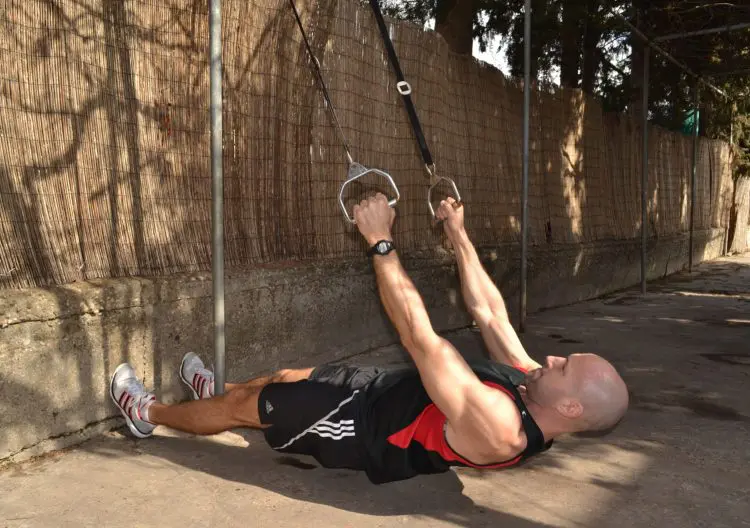
If you’ve got a suspension trainer like a TRX, you have everything you need to do Australian pull-ups at home. In fact, because you can rotate your hands into a neutral or palms facing inward position, suspension trainer Australian pull-ups are often more comfortable and easier on your wrists and elbows than the straight bar version.
Use your suspension trainer according to the manufacturer’s instructions, and make sure your anchor point is strong enough to support your weight.
Level Up Your Fitness: Join our 💪 strong community in Fitness Volt Newsletter. Get daily inspiration, expert-backed workouts, nutrition tips, the latest in strength sports, and the support you need to reach your goals. Subscribe for free!
Check out these awesome suspension trainers if you don’t have one already.
2. Tabletop Australian pull-ups
You can build your back at home using nothing more than a sturdy table. Tabletop Australian pull-ups are an excuse-free exercise!
How to do it:
- Sit on the floor beneath something like a heavy dining table and hold the edge with an overhand grip. Alternatively, grab the edges of the table for a parallel grip.
- Lean back, so your arms and legs are straight. Lift your hips off the floor and brace your core. Pull your shoulders down and back.
- Bend your arms and pull your chest up to the underside of the table. Extend your arms and repeat.
3. Australian pull-ups between chairs
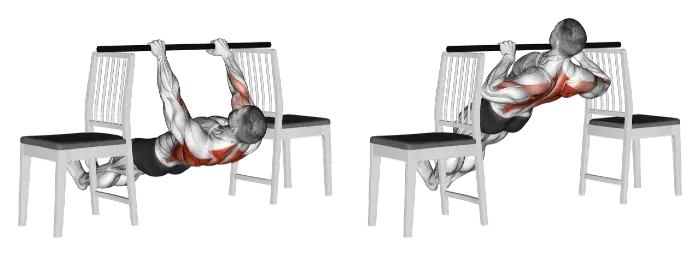
For this variation, place a strong pole between two sturdy chair backs and then rep out as usual. Take care not to unbalance your chairs; move slowly and smoothly to avoid unnecessary wobbles. Put weights on the chairs to make them more stable. Protect the chair backs by placing a towel under the pole.
4. Partner Australian pull-ups
If you are completely stuck for somewhere to do inverted rows, you can always do Australian pull-ups with a partner. However, it’s important to know that you will need a competent helper to do this exercise as they will have to support a lot of your weight with their arms, legs, and back.
How to do it:
- Lie on the floor between your partner’s feet. Reach up and grip their wrists as they grip yours.
- Keeping your legs and body straight, bend your arms, and row yourself up as usual. Extend your arms and repeat.
- Partner: brace your core, bend your knees slightly, and pull your shoulders down and back to reduce your risk of injury. And PLEASE try not to drop your workout buddy!
5. Bent leg Australian pull-ups
Just like push-ups, you can make Australian pull-ups a whole lot easier by bending your legs. This is a good option for beginners and also means that you can do mechanical advantage drop sets to extend your set beyond its usual failure point. To do a mechanical advantage drop set, rep out with your legs straight. Then, when you can’t do any more reps, bend your legs and pump out a few more.
6. Decline Australian pull-ups
If you can do 15 or more regular Australian pull-ups, you are probably ready for a more challenging variation. Raising your feet so your body is declined puts more stress on your upper body. Use an exercise bench or a plyo box. The higher your feet, the harder this exercise becomes.
7. Weighted Australian pull-ups
Just because Australian pull-ups are a bodyweight exercise doesn’t mean you are limited to using your body weight for resistance. Make your workout more demanding by wearing a weighted vest or resting weight plates on your chest or hips. As well as increasing back and biceps activation, resting weights on your body, will increase the core demands of this exercise.
8. Single-arm Australian pull-ups
Increase your strength one arm at a time with single-arm Australian pull-ups. This variation is helpful for identifying and fixing left to right strength imbalances. It also increases core activation, as you’ll have to work hard to stop your torso twisting.
This variation is significantly more challenging than regular Australian pull-ups, so feel free to raise the bar/handles or bend your legs to make it more manageable.
9. Band-assisted Australian pull-ups
If you are coming back from injury, very overweight, or otherwise unable to do regular Australian pull-ups, you can make them a whole lot easier by using a resistance band for assistance. Start off with a strong band and then progress to a lighter one as your strength increases. Simply put the band around your upper back and hold it to take weight off your arms.
Australian Pull-Up Tips
Get even more from this exercise with these handy tips!
Keep your chest up – increase back activation by keeping your chest up. Leading with your chest ensures that you pull your shoulders down and back, which will help your mid-traps and rhomboids get the best workout possible. Keeping your wrists straight and driving your elbows backward will help, too.
Try underhand Australian pull-ups – while this exercise is usually done with an overhand grip, you can do them with an underhand grip too. A palms-up grip increases biceps activation, so you may be able to do more reps or lift more weight. Try it; you might like it!
Create full-body tension – Australian pull-ups are most definitely an upper body exercise, but you’ll get more from them if you tense your entire body. Contract your quadriceps, glutes, and core to keep your body as straight as possible. The more stable your body is, the more force you’ll be able to generate with your back and biceps.
Chalk your hands – don’t let sweaty, slippery hands bring your set to an early end. Chalk your hands to make sure you get the best possible workout. No chalk? Just remember to dry your hands on a gym towel before you start your next set.
Make your workouts progressive – while you could just do more reps as you get stronger, you’ll probably get better results from your workouts if you make the exercise itself more demanding. Raise your feet, wear a weighted vest, or try single-arm Australian push-ups to maintain your progress.
Australian Pull-Ups – Wrapping Up
Australian pull-ups are a great alternative to pull-ups and chin-ups if you aren’t quite strong enough to lift your entire body weight with just your arms. However, they’re more than a steppingstone to pull-ups or a beginner exercise; they’re useful in their own right.
As a horizontal pulling movement, Australian pull-ups are an excellent postural exercise. They involve your core and even your lower body, which is something that chin-ups and pull-ups don’t do. There are also lots of variations you can use to make this exercise easier or harder. It really IS suitable for all levels of exerciser.
Whether you do them instead of chin-ups and pull-ups, or as well as, Australian pull-ups are an effective exercise that deserves to be part of your workouts.
Interested in measuring your progress? Check out our strength standards for Push Ups, Pull Ups, Chin Ups, and more.

